The AMD Radeon RX 480 Preview: Polaris Makes Its Mainstream Mark
by Ryan Smith on June 29, 2016 9:00 AM ESTPower, Temperature, & Noise
Given AMD’s focus on power efficiency with Polaris – not to mention the overall benefits of the move to 14nm FinFET – there is a lot of interest in just how the RX 480 stacks up when it comes to power, temperature, and noise. So without further ado…

When it comes to idle power consumption I'm posting the results I've measured as-is, but I want to note that I have low confidence in these results for the AMD cards. Ever since the GPU testbed was updated from Windows 8.1 to Windows 10, AMD cards have idled 3-5W higher than they used to under Windows 8.1. I believe that this is an AMD driver bug – NVIDIA’s cards clearly have no problem – possibly related to the GPU tested being an Ivy Bridge-E system. In this case I don’t believe RX 480’s idle power consumption is any higher than GTX 960’s, but for the moment the testbed is unable to prove it.
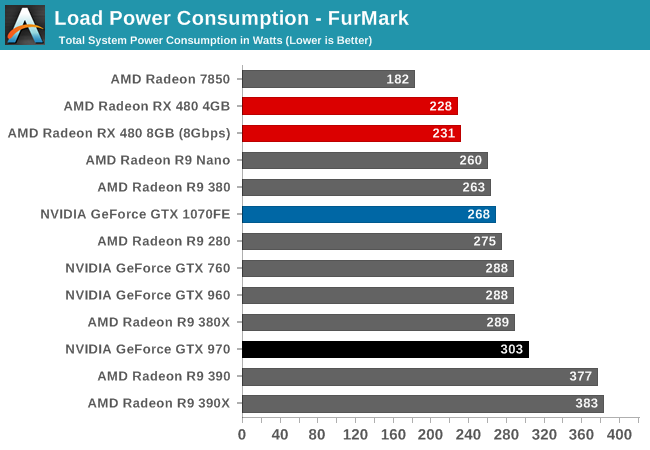
Traditionally we start with gaming load power before moving on to FurMark, but in this instance I want to flip that. As a power virus type workload, FurMark’s power requirements are greater than any game. But because it’s synthetic, it gives us a cleaner look at just GPU power consumption.
Among AMD’s cards, the RX 480 is second to only the Radeon HD 7850 in power consumption. Even then, as a GCN 1.0 card, the 7850 is one of the last AMD cards without fine-grained power states, so this isn’t a true apples-to-apples comparison. Instead a better point of reference is the GCN 1.2 based R9 Nano, which has a 175W TBP. Compared to the R9 Nano we find that the RX 480 draws about 30W less at the wall, which almost perfectly translates to the 25W difference in TBP. As a result we can see first-hand the progress AMD has made on containing power consumption with Polaris.
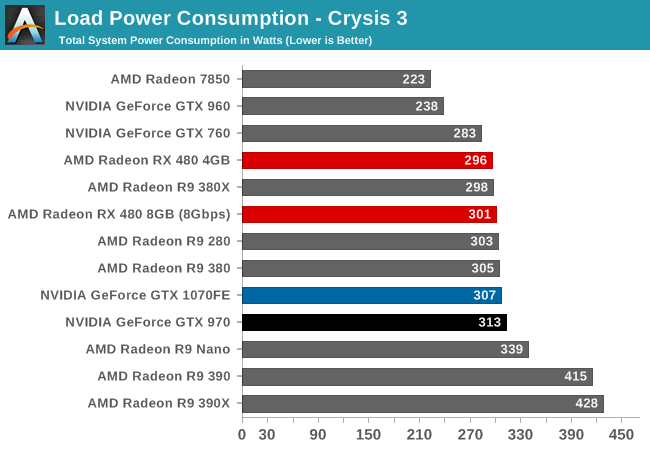
However things are a bit more mixed under Crysis 3. RX 480 is still near the top of our charts, and keeping in mind that higher performing cards draw more power on this test due to the additional CPU workload, the RX 480 compares very favorably to the rest of AMD’s lineup. System power consumption is very close to R9 280/380 for much improved performance, and against the performance-comparable R9 390, we’re looking at over 110W in savings. Hawaii was a solid chip from a performance standpoint, and Polaris 10 picks up where that left off by bringing down the power consumption to much lower levels.
The drawback for AMD here is that power consumption compared to NVIDIA still isn’t great. At the wall, RX 480 is only about 10W ahead of the performance-comparable GTX 970, a last-generation 28nm card. 1070FE further complicates matters, as its performance is well ahead of RX 480, and yet its power consumption at the wall is within several watts of AMD’s latest card. Given what we saw with FurMark I have little reason to believe that card-level power consumption is this close, but it looks like AMD is losing out elsewhere; possibly with driver-related CPU load.
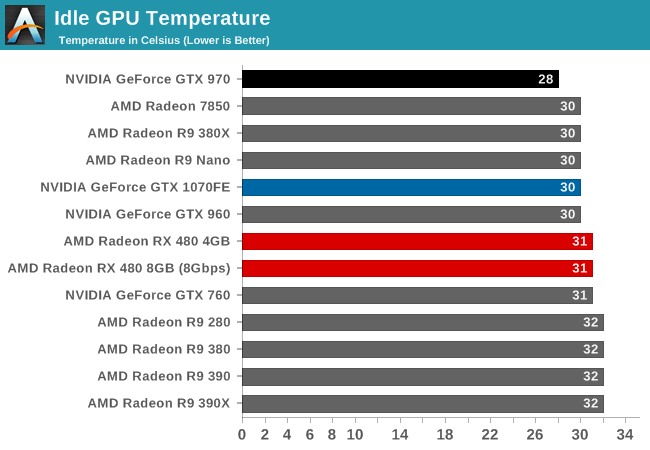
Moving on to idle GPU temperatures, there’s little to remark on. At 31C, the RX 480’s blower based design is consistent with the other cards in our lineup.
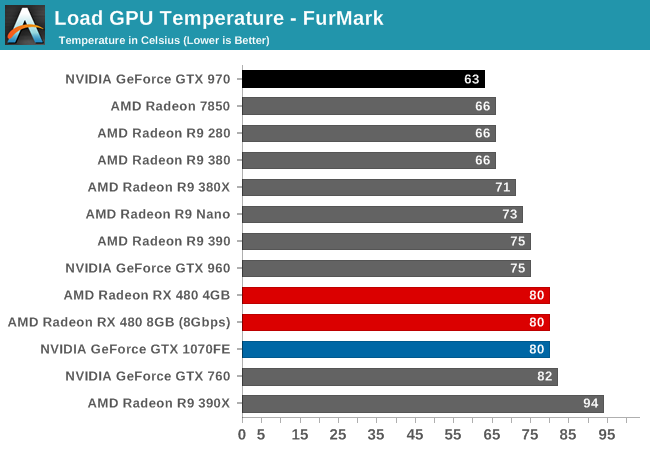
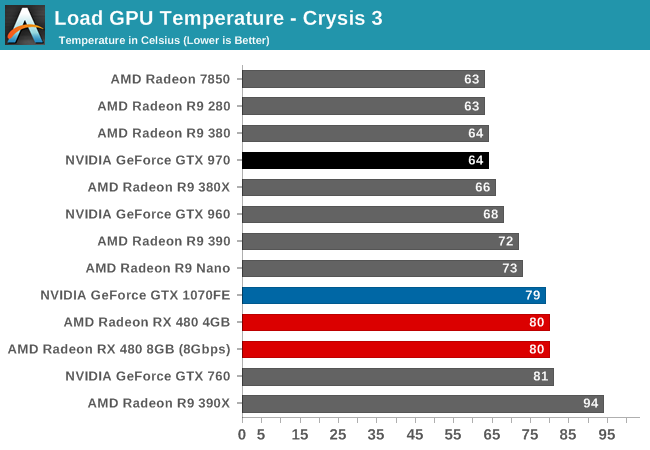
Meanwhile with load temperatures, we get to see the full impact of AMD’s new WattMan power management technology. The RX 480 has a temperature target of 80C, and it dutifully ramps up the fan to ensure it doesn’t exceed that temperature.

With idle noise levels RX 480 once again posts a good result. At 37.8dB, it’s in good company, only meaningfully trailing cards that idle silently due to their respective zero fan speed idle implementations.
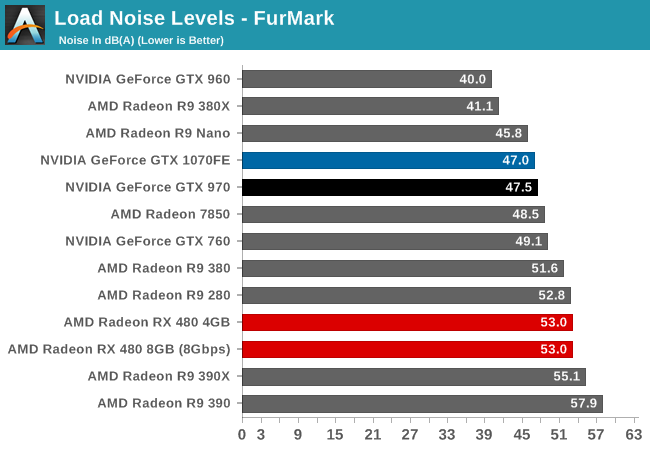
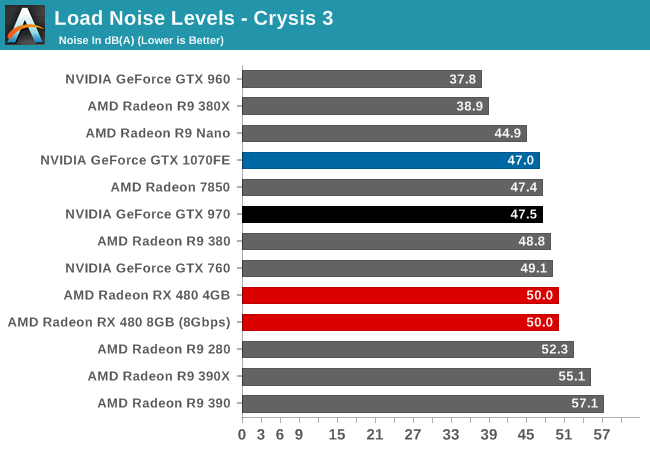
Finally, with load noise levels, RX 480 produces middling (but acceptable) results. Given that we have a mix of blowers and open air coolers here, the RX 480 performs similarly to other mainstream blower based cards. The $199 price tag means that AMD can’t implement any exotic cooling or noise reduction technologies, though strictly speaking it doesn’t need them.










449 Comments
View All Comments
Yojimbo - Thursday, June 30, 2016 - link
Why wouldn't you use data for NVIDIA's GPUs to try to determine the GTX 1060's performance rather than use data from AMD's GPUs? The experience from the 700 series and the 900 series implies that, assuming that the 1060 has two GPCs (half that of the 1080) it should be about 20% faster than the 970 in DX 11 games and so about 20% faster than the RX 480. Pascal seems to be doing better in DX 12 than Maxwell, so it may end up being close to 20% faster than RX 480 in DX 12 games, too.dragonsqrrl - Thursday, June 30, 2016 - link
I'm not using AMDs GPUs to determine the performance of the 1060, I'm using the 1070 and 1080. What I was trying to say in my previous comment was that I've assumed roughly 50% 1080 performance (or around the 970) for the 1060. The RX480 leaks prior to launch suggested 390X-like performance, which led me to believe the 1060 would probably perform a step below it. Apparently the leaks were a bit exaggerated, so I now think the 1060 will be more competitive against the RX480 than I did before.I'm actually curious why your estimate is so different. Am I missing something?
Yojimbo - Thursday, June 30, 2016 - link
OK, first let's look at the 900 series. The GTX 980 was released on September 18, 2014 for $549. It has a 2048:128:64 configuration @ 1126 MHz base clock for 4612 SP throughput. The GTX 970 was released on September 18, 2014 for $329. It has a 1664:104:56 core configuration @ 1050 MHz for 3494 SP throughput. The GTX 960 was released January 22, 2015 for $199. It has a 1024:64:32 core configuration @ 1127 MHz base clock for 2308 SP throughput.
Relative: performance - 980 is 1.32 times 970, price - 980 is 1.67 times 970. performance - 980 is 2 times 960, price - 980 is 2.76 times 960. performance - 970 is 1.51 times 960, price - 970 is 1.65 times 960.
Now the 10 series. GTX 1080 was just recently released and will presumably be available soon for $599. It has a 2560:160:64 configuration @ 1607 MHz for SP throughput of 8228. GTX 1070 was just recently released and will presumably be available soon for $379. It has a 1920:120:64 configuration @ 1506 MHz for SP throughput of 5783. Now the GTX 1060 is rumored to have a 1280:80:48 configuration. It will probably have a clock very close to the 1080 judging by the 900 series clocks. That would give it an SP throughput of 4114. Relative: performance - 980 is 1.42 times 1070, price - 1080 is 1.58 times 1070. speculative: performance - 1080 is 2 times 1060. performance - 1070 is 1.41 times 1060.
Now the GTX 1070 has SP throughput that is 25% more than the GTX 980. It performs 20% to 40% faster than the 980 (in DX11 games. More in DX12 games), averaging more than 30% faster. 4114 SP throughput for the GTX 1060 would make it give it 18% more than the GTX 970. It should then average about 25% faster in DX11 games, and so more than 20% faster than the RX 480.
Now, I know that you were only interested in how I got the performance numbers for the 1060, but I decided to include an argument for pricing as well while I was at it:
The 1070 has a performance/price ratio of 1.11 wrt to the 1080. The 970 has a performance/price ratio of 1.27 wrt to the 980. The 960 has a performance/price ratio of 1.38 wrt the 980. The 960 has a performance/price ratio of 1.09 wrt the 970. You can see the 1070 is priced a lot closer to the 1080 compared to the 970's price relative to the 980, despite the 970 being closer to the 980 in performance compared with the relative performance of 1070 and 1080. The question is why is this the case? Does it have to do something with the defect density of the 14nm node, or something else? My guess is it has to do with the success of the 970 and the amount of competition from AMD in the space the cards occupy. The 970 was enourmously successful, and NVIDIA wants to push up the average selling price of the replacement card if they can, in order to tap into the prior success of the x70 card. Additionally, when the 980 and 970 were released, AMD had more competition for the 970 than for the 980. Therefore the 980 could be prices relatively higher. Now AMD does not really have competition for both the 1080 and the 1070, allowing both those cards to be priced higher. The 1060, however, faces competition. Therefore I think that the expected pricing of the 1060 would be to remain close to the relative price/performance ratio of the 960 wrt the 980, a card with competition compared with a card without much competition, rather than remain closer to the relative price/performance ratio of the 960 wrt the 970, which were both cards with competition. If we divide the price ratio of the 980 to 960 with the performance ratio of the 980 to 960 we get 2.76/2 = 1.38. This represents a conversion factor that will convert relative performance to relative price, under the assumption that the relative price performance ratio of the 980 to 960 also holds for the 1080 to 1060. Since I speculated that the 1080 will have 2 times the performance of the 1060, the 1080 would then cost 2.76 times the 1060 under these assumptions. Since the 1080 costs $599, the 1060 would be expected to cost about $217.
$217 obviously leaves quite a bit of wiggle room for upward pricing pressure of the 1060, such as it falling closer in line with the 1070 price for whaetever reason, and still be well below the $300 that many seem to be claiming. But the point is that a $220 GTX 1060 performing 25% faster than the GTX 970 is well within the range of reasonable expectations given the recent historical data of NVIDIA's cards. If anything the GTX 1080 has even less competition than the GTX 980 had, suggesting the converstion factor might actually be greater (But I doubt it. The 1080 can't be found for the $599 at the moment and part of the reason for that is that the 1080 doesn't have any competition. That larger conversion factor is factored into the actual real world prices but probably not the MSRPs.) So the RX 480 seems to exert no extra pricing pressure on the GTX 1060 than AMD's offerings exerted on the GTX 960 when the GTX 960 was released.
dragonsqrrl - Thursday, June 30, 2016 - link
"Relative: performance - 980 is 1.42 times 1070, price - 1080 is 1.58 times 1070. speculative: performance - 1080 is 2 times 1060. performance - 1070 is 1.41 times 1060."There's something wrong here. If the 1060 is roughly equal to the 980, and the 1080 is 2x the performance of the 1060, the 1080 would also have to be 2x the performance of the 980, which it isn't. I'm not exactly sure where the ratios or logic went wrong, but there's clearly an inconsistency there. The 1080 is about 1.65x the performance of the 980, and about 1.95x the performance of the 970. I'm not using theoretical SP performance, I'm basing this primarily off of real world DX11 performance at 1440p. This is why I assumed it would perform closer to the 970, because it's roughly 50% the performance of the 1080.
Yojimbo - Thursday, June 30, 2016 - link
" If the 1060 is roughly equal to the 980, and the 1080 is 2x the performance of the 1060, the 1080 would also have to be 2x the performance of the 980, which it isn't."There's pretty obviously a typo there. The organization of the information should lead you to know it's a typo. It should read: ""Relative: performance - 1080 is 1.42 times 1070, price - 1080 is 1.58 times 1070. speculative: performance - 1080 is 2 times 1060. performance - 1070 is 1.41 times 1060." Does that clear things up?
" The 1080 is about 1.65x the performance of the 980, and about 1.95x the performance of the 970."
Does that contradict my information? If it does, then show how. It doesn't seem relevant to me, because you don't directly argue against the cross-generational comparison I did make. I established the relative performance of the 10 series to the 900 series by comparing the 1070 to the 980. The 1070 performs on average 30% faster than the 980 in real world games. The relative performance of the cards within their architecture is closely related to their theoretical performance.
"I'm not using theoretical SP performance"
Without considering theoretical performance there's no way whatsoever you can guess the performance of the 1060 because at this point theoretical performance of the 1060 is all we have information for.
sonicmerlin - Friday, July 1, 2016 - link
Yojimbo almost certainly has Aspergers. And yet you read everything he wrote. JesusYojimbo - Friday, July 1, 2016 - link
Why wouldn't you want to read something that's right? Jesuscrimson117 - Wednesday, June 29, 2016 - link
Go away, troll. Don't just post shit like that without backing it up. When can we get downvote buttons on AT comments?"Wrapping things up then, today’s launch of the Radeon RX 480 leaves AMD is in a good position. They have the mainstream market to themselves, and RX 480 is a strong showing for their new Polaris architecture. AMD will have to fend off NVIDIA at some point, but for now they can sit back and enjoy another successful launch."
atlantico - Wednesday, June 29, 2016 - link
He's not wrong, for $200-240 the best GPU on the market is AMD RX480. For "backing that up" check the benchmarks in the article.crimson117 - Wednesday, June 29, 2016 - link
I was referring to the OP's comment "What a massive F-Up by AMD"